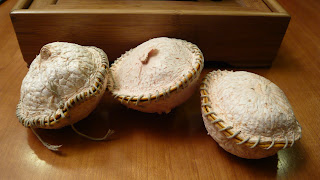Here is a post about my first attempt of making tea grapefruits, and some background of this special tea that was once homemade in many families in South China.
Here is a post about the first tasting of a grapefruit aged tea.
People asked me how to make them. Actually it's very easy, since I am a very clumsy person and can't really do any complicated hand crafting :-p
I took some photos along the way, not very systematically though. Some of the photos are about making tea grapefruits and some are about making tea pomelo. Traditionally in China and Southeastern Asia, pomelo, tangerine and some other local citrus fruits were used. But in New England, grapefruits are the easiest to find and to handle (it's almost impossible to turn inside out an orange or tangerine skin without damaging it), and one can always get organic grapefruits from local market (The outside of skin will have direct contact with tea, so organic is the better choice. Obviously this was not a concern in traditional society, but a big concern nowadays!). Pomelo is nice for this purpose, but it's harder to get, and I didn't find any certified organic ones. Besides, the size of grapefruit is very convenient. Especially when I wasn't 100% sure what I was doing and was still experimenting on different teas to use, it was good to make smaller tea citruses with grapefruits, instead of larger ones with the big pomeloes. But the following pictures include both grapefruit and pomelo.
Step 1 - Carefully cut the fruit skin in two sections (preferably a bigger section and a smaller section). Don't penetrate the white inner lining of the fruit and force out any juice. Then, carefully peel off the two sections. This takes some exercises, but it can be a fun game after dinner :-D
This is a pomelo.
Step 2 - Don't turn the skin inside out immediately. Leave the two sections on counter top, and let them get half way dry (depending on how dry the room is. In our heated room in winter, it took about a few hours). Inspect them from time to time. If you attempt to turn them over too early or too late, they can be easily broken.
This is a pomelo. For pomelo, during Step 1-2, you need to constantly peel off the white inner lining, so that the final fruit skin won't be too thick.
This is a grapefruit:
Step 3 - After the fruit skin is turned over, let it further dry. For my grapefruits, it took about 8-16 hours. And it takes much longer for pomelo. Check them out constantly to monitor how dry they are. If the fruit skin gets too dry, the shape of the final work will be ugly, besides, it may become to dry to let your needle go through when you sew them up. If the fruit skin is not dry enough, it will take very long for the final work to thoroughly dry out, and there is the risk of gaining molds if the fruit is left too humid. But in New England, with heater on in winter, it never gets too humid. So later I discovered that I would rather start Step 4 earlier than later.
Step 4 - When the fruit skin is ready, sew on the rims of the two sections to attach them. When they are half way attached, stuff in the tea. (I've explained in my earlier posts why I chose puerh and Taiwan Wuyi.) Then finish sewing. Try to stuff in as much tea as possible so that the fruit will be maintained in a nice shape later. I used hemp thread. It's tough, nice and natural.
My first tea grapefruit is ugly:
Later I started to make better looking ones :-D
This is a pomelo!
It takes much longer time for a pomelo to thoroughly dry out. I put it on a colander so that it can dry evenly all over.
Finally I wrapped them up with napkin tissue. I've ordered some traditional puerh wrapping cotton paper and would like to use it in the future!
Then I put them in brown paper bags and stored them in a dry corner of my bedroom. I haven't decided it yet whether to put them in some air tight container later. If put in an air tight container, probably they won't need any other treatment in future years. Otherwise, I may need to pan roast them or oven bake them to remove any moisture. Or probably just lay them out in the heated room in winter. My room in winter is so dry that I believe it's very safe for these tea grapefruits.
六堡茶道美学煮茶
3 years ago






































3 comments:
That's great. One time I tried making some of the little ones with Yunnan Hong Cha inside of Mandarin oranges, but they got moldy. It might have been a good idea to put them in the oven - Seattle is most definitely NOT the right climate for this!
I can imagine it must be harder in Seattle! In Southern China, people who home-make these only do it in the driest time of the year, usually the early autumn. It may also help reduce the humidity when the white side of the skin is turned to outside.
Gingko,
These are so cool! How did they turn out? Did the tea store/age well in the skins?
Joe
Post a Comment